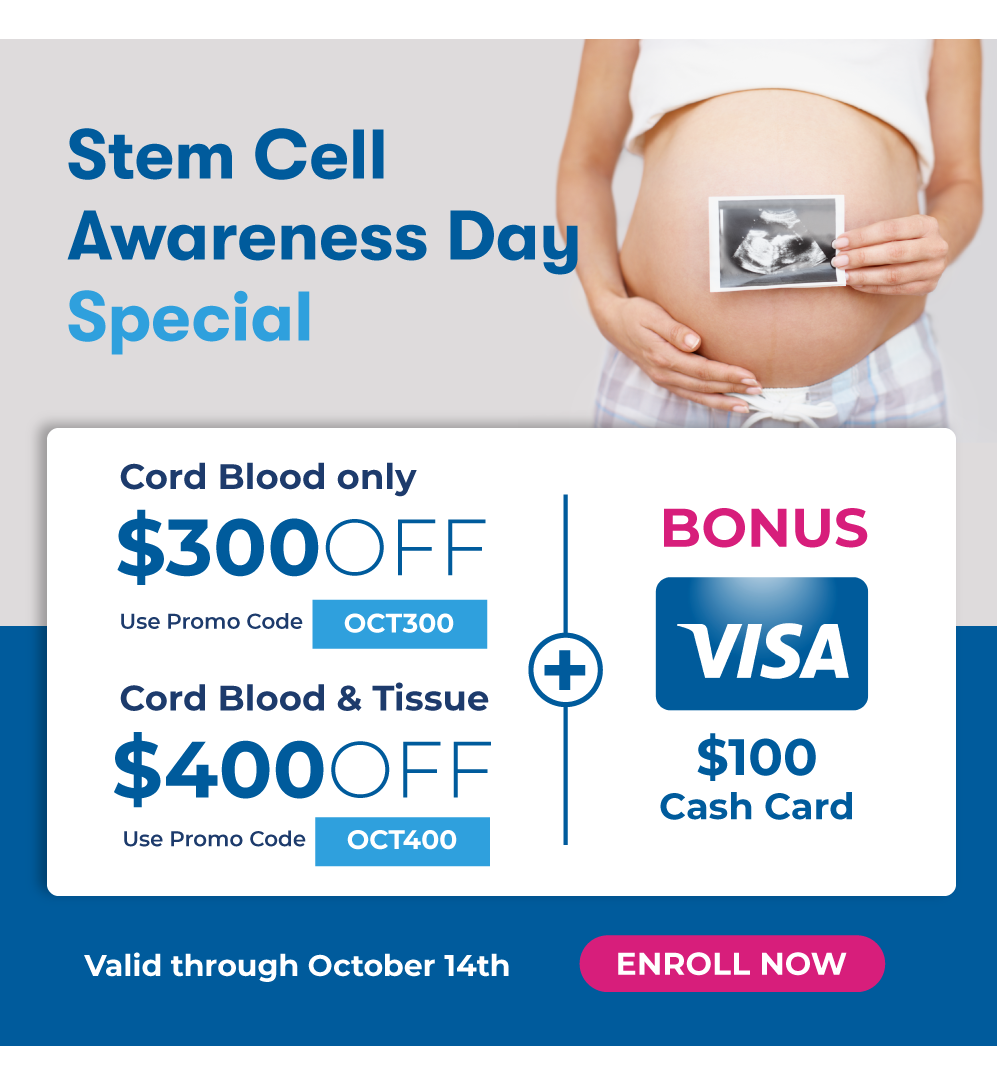Cord Blood Awareness Month 2024 (#CBAM2024) is especially meaningful for the team here at Insception Lifebank. This year marks the 50th anniversary of cord blood being identified as a source of stem cells.1 It’s a discovery that over the past five decades has led to the development of important new treatment options that have helped families dealing with serious, often unforeseen health crises.2
Insception Lifebank is a part of the world’s largest and most experienced private newborn stem cell preservation organization3 allowing us to see firsthand the potentially life-changing impact of stem cell therapy.
This is why we’re dedicating the entire month of July to educating parents about the healing potential of the “smart cells” found in a baby’s umbilical cord blood and cord tissue. We’ll also look ahead at the powerful possibilities newborn stem cells may someday offer in the fields of transplant and regenerative medicine.

Let’s start with cord blood banking
Since the early nineties, families have been taking advantage of the once-in-a-lifetime opportunity to preserve the powerful healing potential of the stem cells found in their baby’s cord blood. It’s a potentially important investment as cord blood can now be used in stem cell transplants to treat over 80 conditions,5 including certain cancers, blood disorders, metabolic disorders, and immune diseases. To date, over 45,000 stem cell transplants have been performed globally, using cord blood from both donor and private family banks.2

The shift to newborn stem cell preservation
Traditionally, cord blood banking involved collecting, preserving, and storing the powerful stem cells found in blood drawn from the umbilical cord. Newborn stem cell preservation takes it a step further by also collecting and storing stem cells from cord tissue, which show promise in the emerging field of regenerative medicine.7

What is regenerative medicine?
Regenerative medicine is an area of science that focuses on restoring or establishing normal function in the body by repairing damaged cells. The aim is to regenerate damaged tissues and organs by either replacing damaged tissue or stimulating the body’s own repair mechanisms. Studies suggest that up to one-in-three people may someday potentially benefit from some type of regenerative therapy in their lifetime.10

Interest in the restorative potential of cord blood and cord tissue has led to more than 500 regenerative medicine clinical trials being initiated using newborn stem cells.9 In fact, mesenchymal stem cells (MSCs), such as the ones found in cord tissue, are one of the most widely researched cell types in regenerative medicine.12,13

The focus on cord tissue stem cells
Why are researchers so interested in the healing potential of newborn stem cells derived from cord tissue? For starters, the unique characteristics of MSCs suggests they have the potential to help treat a wide range of diseases and injuries.13
In addition to their amazing ability to home to the site of injury and modulate an immune system response, 13 MSCs secrete factors that can stimulate cell survival, cell repair, cell growth, and the destruction of damaged cells. 14
MSCs aren’t the only stem cells with a potential future role in regenerative medicine. Researchers are beginning to study the possibility of using endothelial and epithelial cells, which are found in cord tissue, to treat burns, wounds, vascular damage, and other conditions.15,16

Clinical studies indicate that the anti-inflammatory properties of newborn stem cells could possibly have wide-ranging applications. Experts suggest that many age-related diseases are connected to immune system dysfunction,17 making these therapies potentially beneficial. Preserving your baby’s newborn stem cells may potentially open the door to allow access to future advancements in research that could benefit your family.

Potential benefits for your family
There could be peace of mind knowing that preserving your baby’s newborn stem cells may have potential benefits for other members of your immediate family. Depending on the condition being treated, a physician may look to use a child’s own stem cells, or may prefer to use those from a related donor, like a sibling. The increased likelihood of finding a donor match within a patient’s immediate family highlights one of the potential advantages of preserving newborn stem cells with a private cord blood bank instead of relying on a public bank.
Smart cells with powerful possibilities
The impressive healing potential of newborn stem cells has played a key role in many transplant and regenerative medicine treatments. However, at Insception Lifebank, we believe this is only the beginning.
Ongoing research into new therapeutic applications for cord blood and cord tissue cells may someday lead to even more groundbreaking treatment options for families in the future.
Join in the celebration
Help us spread the word about the importance of newborn stem cell preservation during this special Cord Blood Awareness Month. Share this article with friends and family who are expecting to help them learn how these valuable cells may help safeguard their family’s health.
Expecting a child, or have friends or family who are? How about a grandchild? Enroll with Insception today or refer a friend. When someone you refer preserves with Insception Lifebank, you’ll receive a cheque or storage credit to fund your storage fees.*
*Refer-a-Friend Program: See website for referral terms and conditions.
1 Knudtzon S. Blood. 1974;43:357-361. 2 Wagner JE. Cord blood 2.0: state of the art and future directions in transplant medicine. Blood Res. 2019 Mar;54(1):7-9. doi: 10.5045/br.2019.54.1.7. Epub 2019 Mar 21. PMID: 30956957; PMCID: PMC6439299. 3 Internal data on file. 4 Torre P, Flores AI. Current Status and Future Prospects of Perinatal Stem Cells. Genes (Basel). 2020 Dec 23;12(1):6. doi: 10.3390/genes12010006. PMID: 33374593; PMCID: PMC7822425. 5 Mayani, H., Wagner, J.E. & Broxmeyer, H.E. Cord blood research, banking, and transplantation: achievements, challenges, and perspectives. Bone Marrow Transplant 55, 48–61 (2020). https://doi.org/10.1038/s41409-019-0546-9. 6 Zhu X, Tang B, Sun Z. Umbilical cord blood transplantation: Still growing and improving. Stem Cells Transl Med. 2021;10 Suppl 2(Suppl 2):S62-S74. doi:10.1002/sctm.20-0495. 7 Verter, F., Couto, P. S., & Bersenev, A. (2018). A dozen years of clinical trials performing advanced cell therapy with perinatal cells. Future Science OA, 4(10). doi: 10.4155/fsoa-2018-0085. 8 Couto PS, Bersenev A, Verter F. The first decade of advanced cell therapy clinical trials using perinatal cells (2005/2015). Regenerative Medicine. 2017;12(8):953-968. doi:10.2217/rme-2017-0066. 9 U.S. National Library of Medicine. ClinicalTrials.gov. Accessed October 21, 2022. https://clinicaltrials.gov/. 10 Regenerative Medicine. AABB. Retrieved from: https://www.aabb.org/news-resources/resources/cellular-therapies/facts-about-cellular-therapies/regenerative-medicine 11 Sagoo, P., Gaspar, H.B. The transformative potential of HSC gene therapy as a genetic medicine. Gene Ther (2021). https://doi.org/10.1038/s41434-021-00261-x. 12 [1] Vasanthan J, Gurusamy N, Rajasingh S, et al. Role of human mesenchymal stem cells in regenerative therapy. MDPI. https://www.mdpi.com/2073-4409/10/1/54#cite. Published December 31, 2020. Accessed November 17, 2022. 13 Jovic D, Yu Y, Wang D, et al. A Brief Overview of Global Trends in MSC-Based Cell Therapy. Stem Cell Rev Rep. 2022;18(5):1525-1545. doi:10.1007/s12015-022-10369-1. 14 Fan, XL., Zhang, Y., Li, X. et al. Mechanisms underlying the protective effects of mesenchymal stem cell-based therapy. Cell. Mol. Life Sci. 77, 2771–2794 (2020). https://doi.org/10.1007/s00018-020-03454-6 15 Paschalaki KE, Randi AM. Recent Advances in Endothelial Colony Forming Cells Toward Their Use in Clinical Translation. Front Med (Lausanne). 2018;5:295. Published 2018 Oct 23. doi:10.3389/fmed. 2018.00295 16 Saleh R, Reza HM. Short review on human umbilical cord lining epithelial cells and their potential clinical applications. Stem Cell Res Ther. 2017;8(1):222. Published 2017 Oct 10. doi:10.1186/s13287-017-0679-y. 17 Müller L, Di Benedetto S, Pawelec G. The Immune System and Its Dysregulation with Aging. Subcell Biochem. 2019;91:21-43. doi: 10.1007/978-981-13-3681-2_2. PMID: 30888648.
 Sign in
Sign in 


